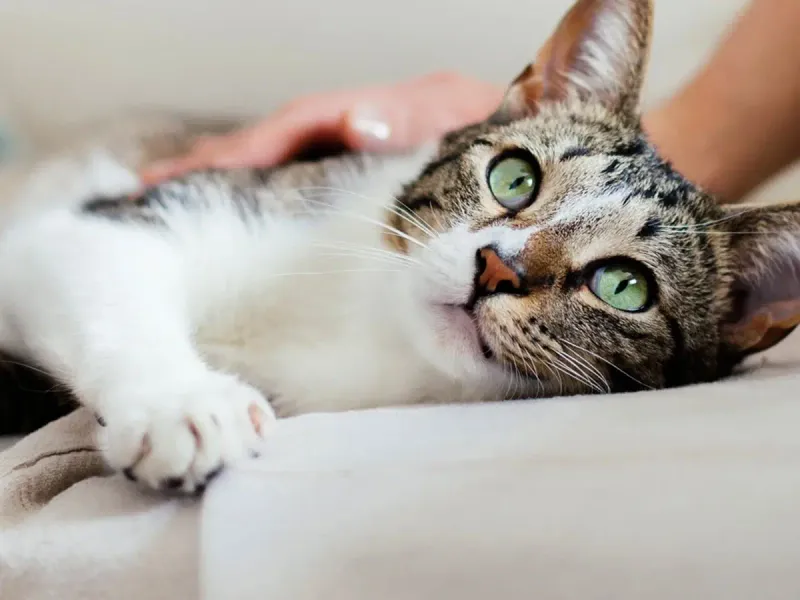📖 Table of Content:
- 1. Their Name – A Sound They’ll Always Recognize
- 2. “Food” or “Dinner” – The Magic Mealtime Words
- 3. “Treat” – The Word That Makes Tails Twitch
- 4. “No” – The Boundary-Setting Command
- 5. “Play” – The Activity Invitation
- 6. “Outside” – The Great Outdoors Beckons
- 7. “Down” – The Simple Directional Command
- 8. “Stay” – The Patience Command
- 1. “Sit” – The Command They Choose to Ignore
- 2. “Bedtime” – The Schedule They Reject
- 3. “Quiet” – The Futile Silence Request
- 4. “Sorry” – The Apology They Can’t Process
- 5. “Tomorrow” – The Future Concept Beyond Feline Comprehension
Cats might seem mysterious, but they actually understand more human language than we think. Our feline friends can learn to recognize certain words, especially when associated with food, play, or routines. However, some words don’t register in their furry brains, no matter how many times we say them. Let’s explore which words your cat understands and which ones fall on deaf ears.
1. Their Name – A Sound They’ll Always Recognize
Most cats respond to their names within months of consistent use. The secret isn’t that they understand the concept of names, but rather that they associate that specific sound with attention, food, or playtime.
Researchers have confirmed that cats can distinguish their names from similar-sounding words. When calling your cat, use a high-pitched, friendly tone – cats respond better to these sounds than lower pitches.
Interestingly, indoor cats typically show stronger name recognition than outdoor cats, likely because they hear their names more frequently in the confined home environment.
2. “Food” or “Dinner” – The Magic Mealtime Words
Through classical conditioning, cats rapidly form associations between food-related words and the positive reinforcement of eating, creating strong neural links to terms like “dinner” or “food.”
Many cat owners notice their previously napping pet suddenly appearing in the kitchen at the mere mention of these words. This isn’t a coincidence – it’s learned behavior reinforced every feeding time.
Some clever cats even distinguish between different meal names like “breakfast” versus “dinner,” especially if you feed them different foods at those times.
3. “Treat” – The Word That Makes Tails Twitch
The word “treat” lights up the pleasure centers in a cat’s brain like few others can. Cats learn this word rapidly because it signals that something immediately rewarding is coming their way.
Even cats who seem to ignore most commands will materialize from thin air when treats are mentioned. The crinkling sound of a treat bag often becomes an additional cue cats recognize, sometimes even more powerfully than the word itself.
Cat behaviorists recommend using treat-words sparingly and consistently to maintain their effectiveness and prevent your cat from becoming desensitized to this powerful motivator.
4. “No” – The Boundary-Setting Command
Contrary to popular belief, cats can understand “no” when taught consistently. The effectiveness comes from your tone of voice rather than the word itself – cats respond to sharp, stern sounds as warning signals.
Successful training pairs the word with immediately stopping unwanted behavior. Clapping hands or making a short hissing sound alongside “no” reinforces the message, as these sounds mimic natural feline communication.
Consistency matters most – if you say “no” but allow the behavior sometimes, your cat will learn to ignore the command entirely. The most effective training happens when everyone in the household uses the same approach.
5. “Play” – The Activity Invitation
Energetic cats quickly learn that “play” signals fun interaction time. Their ears perk up instantly because they associate this word with chasing toys, pouncing games, and quality time with their humans.
Young cats typically show stronger responses to play invitations than older ones. The word becomes even more powerful when paired with visual cues like holding a favorite toy or adopting a playful posture yourself.
Regular play sessions using consistent terminology help build your cat’s vocabulary while strengthening your bond. Some especially intelligent cats even learn specific toy names like “mouse” or “feather” after repeated association.
6. “Outside” – The Great Outdoors Beckons
Outdoor-access cats frequently develop a conditioned response to the word “outside,” associating it with environmental enrichment and exploration opportunities.
The excitement level varies dramatically between cats – those with strong hunting instincts or territorial behaviors show the strongest responses. Some cats even learn to distinguish between different outdoor locations if you use specific terms consistently.
Even strictly indoor cats may recognize this word if you use it while looking through windows together or during supervised balcony time. Their response shows their remarkable ability to connect language with meaningful experiences.
7. “Down” – The Simple Directional Command
With consistent reinforcement, cats are capable of learning directional cues such as “down.” Effective training relies on associating the command with tactile prompts and timely rewards.
This command proves especially useful for cats who jump on counters or furniture where they’re not allowed. Patient training works better than forceful removal – cats respond poorly to negative reinforcement.
Some cat behaviorists recommend using hand signals alongside verbal commands, as cats are highly visual creatures. With consistent practice, many cats learn to hop down from forbidden surfaces when they hear this word, though their compliance always remains somewhat optional in typical cat fashion.
8. “Stay” – The Patience Command
Surprisingly, cats can learn “stay” despite their independent reputation. Teaching this command requires patience and positive reinforcement – treats work wonders as motivation during training sessions.
Start with short durations and gradually extend the time your cat must remain in place. Clicker training enhances success rates by marking the exact moment your cat performs correctly, creating a clearer connection between behavior and reward.
The stay command becomes particularly useful during feeding times, when visitors arrive, or when you need to keep your cat safely in one spot. While never as reliable as with dogs, many cats develop a functional understanding of this useful command.
1. “Sit” – The Command They Choose to Ignore
While some exceptional cats learn to sit on command, most felines simply don’t grasp this concept. Their natural posture already includes frequent sitting, making it difficult for them to connect the command with a specific action they should perform.
The physical structure of cats differs significantly from dogs – their bodies aren’t designed to respond to sitting commands in the same way. Attempts to physically position cats into sits often result in resistance or confusion rather than learning.
Even cat behaviorists acknowledge this limitation – they recommend focusing on commands that align with natural feline behaviors instead of trying to force dog-like obedience on independent-minded cats.
2. “Bedtime” – The Schedule They Reject
Cats fundamentally reject human sleep schedules, making “bedtime” a concept they cannot comprehend. Their crepuscular nature (most active at dawn and dusk) means their internal clocks operate differently from ours.
Repeated use of bedtime routines may create some association, but cats follow their own biological rhythms regardless. The infamous “zoomies” at 3 AM demonstrate their disregard for human sleep preferences.
Some cat owners report limited success with pre-bedtime play sessions that tire cats out, but the word itself holds little meaning. Unlike dogs who may settle down on command, cats simply sleep when they decide it’s time – not when told.
3. “Quiet” – The Futile Silence Request
Telling a vocal cat to be “quiet” rarely produces results. Cats meow specifically to communicate with humans, not other cats, making vocalization an intentional behavior they’re unlikely to stop on command.
Siamese, Oriental breeds, and some domestic cats are naturally talkative due to genetics. Their vocal nature isn’t something they can simply turn off when requested – it’s hardwired into their communication style.
Instead of trying to silence them, experts recommend addressing the underlying need behind the meowing. Cats typically vocalize for specific reasons: hunger, attention, discomfort, or territorial announcements. Understanding and addressing these needs works better than attempting to teach the concept of quietness.
4. “Sorry” – The Apology They Can’t Process
When you say “sorry” for stepping on your cat’s tail, they don’t grasp the word—but they do sense your tone. For them, it’s not the apology, it’s how you say it.
Unlike humans, who value verbal reconciliation, cats operate on immediate cause-and-effect. They may respond positively to gentle tones or treats that follow “sorry,” but the concept of forgiveness remains foreign to their minds.
Cat behaviorists point out that felines live entirely in the present moment without dwelling on past offenses. Rather than verbal apologies, repairing the relationship through positive interactions and respectful handling matters more to your cat than any apologetic words.
5. “Tomorrow” – The Future Concept Beyond Feline Comprehension
Try telling your cat “we’ll play tomorrow,” and you’ll just get a blink. Cats don’t think about the future—they respond to what’s happening right now and what they’ve learned to expect.
When you promise your cat something “tomorrow,” they cannot connect the delay with the eventual fulfillment. This explains why cats may wake you at dawn for breakfast despite your weekend sleep-in plans – they respond to internal cues and established patterns, not verbal promises about future events.
This limitation actually showcases their remarkable adaptation to a hunter’s lifestyle, where immediate awareness matters more than long-term planning. Their present-focused minds make them masters of the moment rather than worriers about tomorrow.













